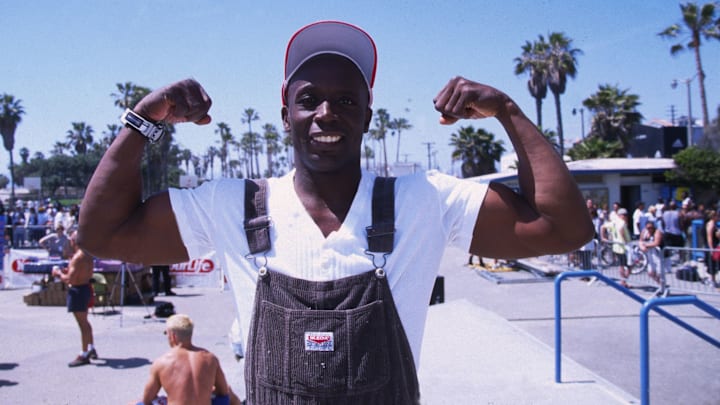Jane Fonda was gone, and the exercise video craze had appeared to have left with her. The Oscar-winning actress who popularized aerobics with a series of video cassette tapes in the 1980s and helped usher in a national fitness focus that bordered on narcissism had returned to her acting career. None of her obvious heirs—Jake Steinfeld; Denise Austin; the sculpted, first-name-only Gilad—could seem to equal her cultural standing. Americans were faced with the prospect of going to an actual gym.
Where others saw a dead genre, Billy Blanks and Paul Monea saw opportunity. Blanks was a lifelong martial artist and low-budget film actor who had been refining a kickboxing cardio routine for decades; Monea was an infomercial king who made headlines with the Stimulator, a device that promised to cure backaches despite being little more than a barbecue grill igniter with finger grips.
In less than seven months, Blanks’s name would eventually surpass Fonda’s as a VHS exercise icon using a simple system that would be known the world over as Karobics.
When he found out Karobics was already trademarked, he renamed it Tae Bo.
Karobics began in 1976, the year Bill Conti’s theme to Rocky became an anthem for anyone in a sweatsuit. Blanks, then 21 years old and a regular on the competition karate circuit, used it as a morale booster for workouts in his basement, shadowboxing and kicking into the air until he was exhausted.
After stints as a janitor and chemical plant worker, Blanks moved to Los Angeles in the late 1980s, intending to parlay his athletic physique into an action film career: He scored parts in video store staples like Bloodfist and The King of the Kick Boxers. At the same time, he wanted to propagate Karobics among the city’s image-obsessed population, opening a fitness studio in Sherman Oaks and earning the respect of celebrity clientele like boxer Sugar Ray Leonard, Ashley Judd, and Sinbad.
“It’s the best,” the comedian told the Chicago Tribune in 1996. “It’s the baddest.”
Tossing the Karobics name, Blanks embraced Tae Bo, a martial arts and dance regimen that promised to burn hundreds of calories per session. A hybrid of Tae Kwon Do and boxing, Blanks said it stood for "Total Awareness of Excellent Body Obedience." Not wishing a repeat of Karobics, he trademarked it in 1992.
Having studied Fonda’s tapes and how to count beats in ballet classes, Blanks was optimistic his workout would have national appeal. One of the home video distributors he approached early on disagreed, insisting that a black male would have problems convincing a mostly white, mostly female demographic to buy his tapes. Irked, Blanks broke off talks and decided to side with Paul Monea, an Ohio-based producer who sensed Blanks had the kind of charisma that played well in the early morning infomercial hours.
Monea, however, wanted Blanks to peddle exercise equipment. After deliberation, Blanks convinced him that a Tae Bo instructional would prove more profitable. There were already numerous celebrities enrolled in his classes that would be willing to provide video testimonials at no charge.
Monea was convinced. In August 1998, commercials and half-hour spots for Tae Bo began airing. For $59.85, consumers could purchase four workout tapes led by Blanks urging them to leave a puddle of sweat on their living room floors.
The infomercial aired up to 2000 times a day across various markets, costing Monea $1.5 million a week in airtime purchases. But it proved to be a worthy investment: in less than a year, Tae Bo would gross $80 million. The tapes outsold every major home video release of 1999, including The Matrix and Saving Private Ryan.
Previously known only to his Sherman Oaks regulars and karate enthusiasts, Blanks was suddenly inundated with up to 80 calls an hour from news outlets. (He shunted them off to a publicist.) So many people made a pilgrimage to his studio that staff would have to turn most of them away. Bantam Books paid a reported $1.2 million advance for a fitness guide. Blanks was even installed on Oprah for a guest spot—for an entire week.
Like any success in the fitness industry, Tae Bo was besieged by copycats. Blanks’s legal team issued 60 cease and desist letters a week to regional gyms advertising classes using the name without permission. To avoid litigation, prospective Tae Bo instructors could take a certification class from Blanks for $995. Those that didn’t were forced to lead derivative classes like Gotham Box, which married (loose) self-defense maneuvers with a regimented workout.
It was a flattering, if expensive, form of imitation. But Blanks was less charmed by litigation that started to bubble up from within his own inner circle. Sugar Ray Leonard, who had endorsed Tae Bo as a favor to his friend, filed a lawsuit against Monea for using his name without permission. Later, Blanks would struggle with Monea himself, alleging that his partner had cut him an unfavorable deal and had aligned Blanks’s own lawyers against him. (Monea denied the accusations: according to , the two settled out of court.)
The legal tussles took the fight out of Banks, who grew concerned the Tae Bo name was entering legally murky territory. By 2008, the tapes had slowed to a trickle, with Blanks in Japan marketing a new routine he dubbed Billy’s Boot Camp. (It sold one million copies overseas.) When he returned to the States, Tae Bo had been dethroned by new fitness trends: SoulCycle, CrossFit, and the higher-energy output of cardio sermons by the likes of Shaun T.
Now 60, Blanks continues to teach Tae Bo in both Sherman Oaks—his son now owns the school—and a location in Dana Point, California. New iterations dubbed Tae Bo Evolution and Tae Bo 2.0 promise to incorporate more equipment and variety. If instructors want to stick with a classic, they can be still be certified by Blanks personally—now for a more reasonable $250.
